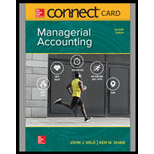
Net present value method is a measure to compare the current worth of cash inflows and current worth of cash outflows to determine the profitability of an investment decision.
Payback Period:
Payback period refers to the time period needed to recover the amount invested in project from the
Formula to calculate payback period,
Cash flow is as statement of sum total of income received also referred as cash inflows and expense incurred referred as
To compute: Payback period and net present value (NPV) of the investment.
Explanation of Solution
Payback Period
Given below is the table for the computation of payback period:
| Year | Net cash flows ($) | Cumulative net cash flows ($) |
| 0 | | |
| 1 | 1,000 | |
| 2 | 2,000 | |
| 3 | 3,000 | |
| 4 | 6,000 | |
| 5 | 7,000 | 4,000 |
Formula to calculate total payback period,
Substitute $3,000 for negative cumulative cash flows of 4th year and $7,000 for net cash flow of the 5th year.
Hence, payback period of investment of $15,000 is 4.4 years.
Net Present Value (NPV)
Given below is the table for the computation of Net Present Value (NPV).
| Year | Cash flows ($) | Present value of 1 at 10% | Present value of net cash flows ($) |
| 1 | 1,000 | 0.9091 | 9,09.10 |
| 2 | 2,000 | 0.8264 | 1,652.80 |
| 3 | 3,000 | 0.7513 | 2,253.90 |
| 4 | 6,000 | 0.6209 | 4,098.00 |
| 5 | 7,000 | 4,346.30 | |
| Total cash flows | 13,260.10 | ||
| Invested amount | 15,000 | | |
| Net present value | | ||
Hence, NPV for investment is $(1,739.90) as the total flows did not recover the invested amount of $15,000.
Payback Period
Given below is the table for the computation of payback period according to the website detail:
| Year | Net cash flows ($) | Cumulative net cash flows ($) |
| 0 | | |
| 1 | 7,000 | |
| 2 | 6,000 | |
| 3 | 3,000 | 1,000 |
| 4 | 2,000 | 3,000 |
| 5 | 1,000 | 4,000 |
- As per above table, the cash flow is positive after 2nd year, hence it can be said that cash flow is received after 2nd year.
- In order to find the actual payback period, divide the negative cumulative net cash flows of 2nd year by the net cash flow of the 3rd year, then add the given duration to the 2nd year.
Formula to calculate total payback period,
Substitute $2,000 for negative cumulative cash flows of 2nd year and $7,000 for net cash flow of the 3rd year.
Hence, payback period of investment of $15,000 is 2.66 years.
Net Present Value (NPV)
Given below is the table for the computation of Net Present Value (NPV).
| Year | Cash flows ($) | Present value of 1 at 10% | Present value of net cash flows ($) |
| 1 | 7,000 | 0.9091 | 6,363.70 |
| 2 | 6,000 | 0.8264 | 4,958.40 |
| 3 | 3,000 | 0.7513 | 2,253.90 |
| 4 | 2,000 | 0.6830 | 1,366.00 |
| 5 | 1,000 | 0.6209 | 620.90 |
| Total cash flows | 15,562.90 | ||
| Invested amount | 15,000 | | |
| Net present value | | ||
Hence, NPV for investment is $562.90.
Hence, the project as per book sum has higher payback period and negative NPV as compared to website sum. This will result in rejection of the project.
Want to see more full solutions like this?
Chapter 11 Solutions
Managerial Accounting - Connect Access
- I am trying to find the accurate solution to this general accounting problem with the correct explanation.arrow_forwardBrightview Components Ltd. expected an overhead cost of $425,000 for its packaging cost pool and an estimated 17,000 packaging operations. The actual overhead cost for that cost pool was $460,000for 18,200 actual packaging operations. The activity-based overhead rate (ABOR) used to assign the costs of the packaging cost pool to products is __arrow_forwardElba Industries recently reported an EBITDA of $12.5 million and a net income of $3.7 million. It had $3.2 million in interest expense, and its corporate taxrate was 40%. What was its charge for depreciation and amortization?arrow_forward
- Pedro Manufacturing expects overhead costs of $360,000 per year and direct production costs of $15 per unit. The estimated production activity for the 2023 accounting period is as follows: 1st 2nd 3rd 4th Quarter Units Produced 10,000 9,500 8,000 10,500| The predetermined overhead rate based on units produced is (rounded to the nearest penny): a. $9.47 per unit b. $10.00 per unit c. $8.05 per unit d. $11.25 per unitarrow_forwardPlease provide the answer to this general accounting question with proper steps.arrow_forwardCan you solve this general accounting question with accurate accounting calculations?arrow_forward

 AccountingAccountingISBN:9781337272094Author:WARREN, Carl S., Reeve, James M., Duchac, Jonathan E.Publisher:Cengage Learning,
AccountingAccountingISBN:9781337272094Author:WARREN, Carl S., Reeve, James M., Duchac, Jonathan E.Publisher:Cengage Learning, Accounting Information SystemsAccountingISBN:9781337619202Author:Hall, James A.Publisher:Cengage Learning,
Accounting Information SystemsAccountingISBN:9781337619202Author:Hall, James A.Publisher:Cengage Learning, Horngren's Cost Accounting: A Managerial Emphasis...AccountingISBN:9780134475585Author:Srikant M. Datar, Madhav V. RajanPublisher:PEARSON
Horngren's Cost Accounting: A Managerial Emphasis...AccountingISBN:9780134475585Author:Srikant M. Datar, Madhav V. RajanPublisher:PEARSON Intermediate AccountingAccountingISBN:9781259722660Author:J. David Spiceland, Mark W. Nelson, Wayne M ThomasPublisher:McGraw-Hill Education
Intermediate AccountingAccountingISBN:9781259722660Author:J. David Spiceland, Mark W. Nelson, Wayne M ThomasPublisher:McGraw-Hill Education Financial and Managerial AccountingAccountingISBN:9781259726705Author:John J Wild, Ken W. Shaw, Barbara Chiappetta Fundamental Accounting PrinciplesPublisher:McGraw-Hill Education
Financial and Managerial AccountingAccountingISBN:9781259726705Author:John J Wild, Ken W. Shaw, Barbara Chiappetta Fundamental Accounting PrinciplesPublisher:McGraw-Hill Education





